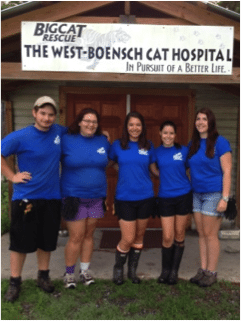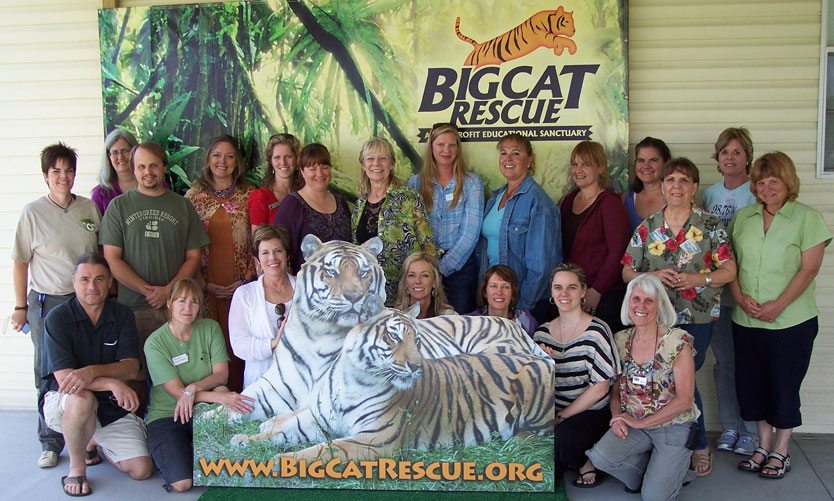Big Cat Rescue Hands On Training
Big Cat Rescue Hands On Training
Mission
Big Cat Rescue in Tampa, FL is the world’s largest sanctuary in the world for abused, abandoned and orphaned wild cats (lions, tigers, cougars, bobcats etc.) accredited by the Global Federation of Sanctuaries (GFAS).
The mission of the sanctuary is to provide the best home we can to the animals in our care and to end abuse of big cats in captivity and avoid extinction in the wild We do this by educating the world about the plight of these wild cats both in captivity, where the vast majority are kept in inhumane conditions, and in the wild, where they face extinction due largely to poaching, habitat loss and animal/human conflict.
The sanctuary houses 13 different species of wild cat, more than any other facility in the world. The sanctuary is held out by GFAS and generally viewed as the model not only for animal care but also for responsible, efficient financial and operational management and particularly for its extensive educational programs. The latter are devoted to building awareness of the plight of wild cats
Training Program
A critical part of our education efforts is our training program. Trainees can come for up to a year. They live on property and are immersed in our philosophy, procedures and management techniques. The sanctuary has 14 paid staff who handle the administrative responsibilities and supervise the trainees.
The primary purpose of the training program is to train individuals on how animal care across this uniquely broad array of species should be done safely and in a way that provides a truly humane existence. There is extensive rigorous class training that the trainees must progress through during their stay. Then, as they become qualified, the trainees are given increasing levels of hands on experience.
The hands on training experience is absolutely critical to obtaining safe future employment as a keeper of these dangerous animals. Much like a commercial airline pilot should not be hired to fly a large jet based on classroom training; keepers should not be hired to care for these incredibly dangerous animals without extensive hands on training. The number of keeper deaths, lost limbs and other serious injuries is an unfortunate testimony to the lack of training. Big Cat Rescue provides a curriculum and intensity of experience that is not available anywhere else in the world. The level of hands on experience demonstrating the ability to apply the classroom learning safely and responsibly over a sufficient period of time is critical to the credential we provide to a trainee as a qualified keeper.
The training program is not solely for the benefit of the trainees and the future employment prospects. It is a critical part of our mission to impact many more animals than we can care for at our location. The trainees become in effect “missionaries” who take with them the philosophy and procedures we teach for humane care. They then question the substandard practices they find at other facilities and become catalysts for improved care at those facilities. This is a vivid contrast to people who are hired at a substandard facility and end up believing that what they experience there is acceptable.
International Trainees

Many of our requests to enter the training program originate overseas. There simply is no other training program like ours anywhere in the world, and particularly not outside the US. But there are facilities all around the world that house big cats who need care. Our training program provides these international trainees with a unique, world renowned credential that makes them highly qualified for jobs back in their home countries.
Supervision
We have an Operations Manager who oversees all of the animal care and property maintenance. On most days we also have a Coordinator who assigns tasks, at other times the Operations Manager is the Coordinator. Their primary role is to supervise the trainees. Every day trainees are assigned to specific tasks that vary during the day and the Operations Manager and/or Coordinator supervise and check their progress and provide one on one or sometimes group guidance as needed. We also have a Training Manager whose responsibilities include taking applications, filtering for those of interest, interviewing (along with the Operations Manager who also interviews separately), tracking and making sure the trainees get their classes and range of hands on experience during their training period here, and being the primary contact person for any issues any individual trainees have. Our trainees do not replace any of our existing staff and they do not fill any of our existing positions. They are supervised / trained throughout their tenure at Big Cat Rescue.
Class Training
Below is a list of the classes offered during the program. In many cases the classes are progressive, i.e. requiring completion of one or more other classes before one can be taken. In this way the learning evolves over time and we can gear the class structure to the length of the training.
The classes fall into a number of categories of training.
Animal care. The cat care training is primary. This includes:
– cage cleaning.
– feeding – this is a much far more involved process than the word indicates because there are complex charts showing the individualized nutrition requirements for each cat depending on species, age and medical needs.
– administering medication
– assisting with advance medical procedures like transporting cats on and off site for medical tests or procedures and assisting with and observing surgeries.
– constant observing for any medical issues. In the wild, cats who show infirmity become prey. So they are extremely good at hiding injuries and illness. The observation process requires knowledge of species specific behaviors and the ability to observe any changes in eating, stool, motion or habits.
Educating the public. Other classes involve learning to teach others, again a critical part of the sanctuary mission. Trainees learn how to give 90 minute tours that include the specific histories of the individual cats, information about each of the 13 species, and the challenges each species face in captivity and in the wild. These challenges vary widely by species. In captivity they range from tigers bred incessantly to be used for cub petting and then discarded to lion meat served as an exotic food. In the wild they range from tigers poached for their parts to panthers in Florida having their habitat increasingly diminished and their natural pattern of roaming disrupted creating small groups with insufficient genetic diversity to survive.
Sanctuary management. Running a successful sanctuary involves more than animal care. It involves understanding sanctuary finances and significant amounts of facility maintenance that needs to be done safely. Our CFO gives a class on financial management and the trainees receive training in some of the donor relations practices that have made us successful.
Hands On Training
KEEPER TRAINING FOR ONSITE TRAINEES
LEVEL 1 Training Program and Certifications:
Level 1 Keeper Trainee: A Level 1 onsite trainee may become a Keeper Trainee only after performing Partner Trainee program for an initial period of time to be determined by the Operations Manager. Keeper Trainees are considered a probationary level. A trainee serving at this level will train under the direct supervision of a ranking volunteer. Keeper Trainee program may include feeding and care of omnivores and live prey rats, sorting produce, cleaning small cat enclosures (Geoffrey Cats to Siberian Lynx), assisting animal feeders, guest sign in, serving as a tour back up for day tours and kid’s tours, gift shop assistant, data entry, housekeeping, landscaping, domestic cat care, daily chores, perimeter checks, and miscellaneous projects.
Level 1 Keeper Trainee Classes and Certifications (Timeline only a guideline, may vary):
Day 1: Orientation
Week 1: Tour Back Up, Gate Operation, and Guest Sign In, Human First Aid
Week 2: Animal Emergency, Animal Observation, Kids Tour Guide and Certification
Week 3: Tour Guide and Certification, Cleaning Small Cats, Red Level Quarantine Cleaning
Week 4: Events
After the completion of Week 4 and the successful completion of all of the Keeper Trainee Classes the Keeper Trainee will advance to Level 1 Keeper level. The trainee will be required to complete all certifications for Kids Tour Guide, Tour Guide, and Small Cat Cleaning prior to the end of the onsite trainee program.
Level 1 Keeper: Keeper training activity may include Beginner Trainee tasks, feeding small cats (Geoffrey Cats to Siberian Lynx), red level enrichment and red level 1 (click and treat with small cats) operant with small cats, leading projects, and training others. A minimum of one night tour must be observed during the Level 1 onsite trainee period and documented on the Night Tour Guide Certification sheet.
Level 1 Training Program and Certifications:
Week 5: Small Cat Feeding Class and Certification in one feeding section, Enrichment Class and Red Level Certification, Operant Training Class and Red Level 1 Certification
LEVEL 2 Training Program and Certifications:
Level 2 Keeper: The Level 2 onsite trainee program is reserved for returning trainees who showed exceptional skill and ability as a Level 1 onsite trainee. Acceptance into this program is contingent upon the unanimous agreement of our selection committee. Level 2 Keeper trainee program may include Level 1 refresher, cougar cleaning, yellow level enrichment, red level 2 (basic commands with small cats) operant, participate in feeding tours, leading animal husbandry tasks and projects, and ensuring maintenance of onsite trainee housing. A minimum of one night tour must be observed during the Level 2 onsite trainee period and documented on the Night Tour Guide Certification sheet.
Level 2 Keeper Classes and Certifications:
Cougar Cleaning, Yellow Level Quarantine Cleaning Certification, Small Cat Feeding Certification in a second feeding section, Feeding Tour Guide and Certification (speaking portion), Yellow Level Enrichment Certification, Red Level 2 Operant Certification
LEVEL 3 Training Program and Certifications:
Level 3 Senior Keeper: The Level 3 onsite trainee program is reserved for returning onsite trainees who showed outstanding skill and ability as a Level 2 trainee. Acceptance into this program is contingent upon the unanimous agreement of our selection committee. Level 3 Keeper trainee training may include Level 1 and Level 2 refresher tasks, big cat cleaning, green level enrichment, red level 3 (advanced commands with small cats) and yellow level 1 & 2 operant (click and treat and basic commands with cougars), and participate keeper tours. A minimum of one night tour must be observed during the Level 3 onsite trainee period and documented on the Night Tour Guide Certification sheet. Each household will be assigned one House Leader who is either a Level 3 or 4 trainee. The House Leader will be responsible for; giving new trainees the Kitten Nursing Class within their first week, overseeing all of the foster kitten care in their house, serving as the main contact with the Foster Kitten Program Manager, and communicating housing needs and issues with the Operations Manager.
Level 3 Senior Keeper Classes and Certifications:
Big Cat Cleaning, Green Level Quarantine Cleaning Certification, Small Cat Feeding Certification in a third feeding section, Green Level Enrichment Certification, Red Level 3 Operant Certification, Yellow Level 1 & 2 Operant Certification, Keeper Tour Guide and Certification (speaking portion)
LEVEL 4 Training Program and Certifications:
Level 4 Senior Keeper: The Level 4 onsite trainee program is reserved for returning onsite trainees who stood out as the best of the best and showed excellent skill and ability as a Level 3 trainee. Acceptance into this program is contingent upon the unanimous agreement of our selection committee. Level 4 Keeper trainee program may include Level 1, 2, and 3 refresher, big cat feeding, participate in night tours, green level 1 & 2 operant (click and treat and basic commands with big cats), and assisting with meds preparation and administration.
Level 4 Senior Keeper Classes and Certifications:
Big Cat Feeding and Certification, Green Level 1 & 2 Operant Certification, Night Tour Guide and Certification, Meds Administration
LEVEL 5 Training Program and Certifications:
Level 5 Senior Keeper: The Level 5 onsite trainee program is reserved for returning trainees who stood out as the best of the best and showed excellent skill and ability as a Level 4 onsite trainee. Acceptance into this program is contingent upon the unanimous agreement of our selection committee. Level 5 Keeper trainee curriculum may include Level 1, 2, 3, & 4 refresher training, administering medications (minimum of 4 times per month), coordinating keeper trainees and trainees (minimum 2 days per week), special project assignment, and hospitalized animal care. The duration of the Level 5 onsite trainee program is 52 weeks, which includes 14 vacation days. The training schedule for Level 5 onsite trainees is 5 days a week serving a minimum of 48 hours per week. A grant of up to $1,500 for airfare will be awarded to each trainee that is accepted as a Level 5 trainee to cover the cost of transportation to return for the onsite trainee program.
Level 5 Senior Keeper Classes and Certifications:
Meds Administration Certification, Coordinator Training and Certification, Hospitalized Animal Care Class
APPLICATIONS FOR GRADUATION TO NEXT LEVEL
A trainee may apply for advancement to the next level onsite trainee program or to be accepted into the onsite trainee program by submitting an application for graduation via email to the Committee. Applications can be found on the BigCat.me site. The trainee should apply for advancement prior to the end of the current onsite trainee program only after having completed all of the required classes of that onsite trainee program level. Certifications do not have to be completed prior to applying for graduation, but are required to be completed prior to the end of the current onsite trainee program.
The Committee will consult with the appropriate Coordinators and Operations Manager as well as fellow trainees to receive feedback on the applicants overall performance within the program. If the Coordinator or Operations Manager are not confident in the applicant’s current abilities the Committee will take this into advisement and may speak with and encourage the applicant to focus on sharpening these specific skills in question and then reapply for graduation after a designated period of time established by the Committee. The Coordinator and Operations Manager will also be advised to monitor the applicant’s improvements over the designated period of time after which the Committee, the Coordinator and Operations Manager will reevaluate the application for graduation.
If 3 months or less transpires between the end of the current onsite trainee Level and the beginning of the next onsite trainee Level, the trainee will move forward with the advanced training upon their return. Depending on circumstances it may be required for the trainee to spend a brief amount time refreshing themselves with the particulars of previous onsite trainee program before advancing.
No more than a maximum of 6 months may transpire between the end of the current onsite trainee Level and the beginning of the next onsite trainee Level. If 3-6 months transpires between Levels, the trainee will be required to; complete all of the training classes of the previous onsite trainee Level(s) and half of the required certifications for each class as well as spend the first 4 weeks of the onsite trainee Level performing the previous onsite trainee program(s) details. At week 5 the trainee will then be able to advance in their training.







Hey Guys,
Lot’s of love from INDIA
I wish to know more details about the course & the fee structure. (Total fee structure & level-wise segregated)
Thank You.
I would love to be a volunteer and now. Wanted to work very closely with the big cats for a few years now and I just read about this effort. I’m 5 miles away and starting to bike to the spot now in 30 min